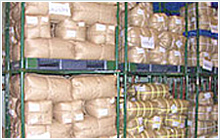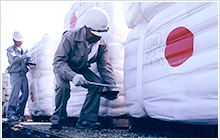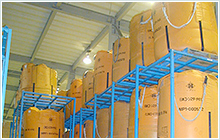
Rice storage has been intricately tied to warehouse operation in Japan for centuries as the result of Japan's historical background. Rice storage and management requires a thorough understanding of the physiology, chemistry, and physical properties of rice, and rational management of warehouses based on their structure and functions. This means that it is essential to keep fumigation to an absolute minimum, quality degradation must be prevented, and management must maintain the value of the rice as a sales product. We strive to ensure quality using new approaches and theories focused on low temperature storage. The majority of the rice we handle is minimum access import rice designated as the result of WTO negotiations. At Shimizu Port 6,000 to 10,000 tons of imported rice are unloaded from each ship. We play a central role in warehousing that rice, so our managers must provide accurate and precise service, from advance negotiations with clients to coordination with port cargo handling staff.
We also have an extensive track record of working with tea. Tea leaves brought in from tea growing areas are stored in climate controlled chilled warehouses in order to preserve their quality. Paper bags remain the packaging format of choice, as they have since long ago, and we perform highly granular lot management. We have experience not only with green tea, but also black tea and oolong tea.
 government-controlled rice
government-controlled rice Tea leaves
Tea leaves Inspection of government-controlled rice
Inspection of government-controlled rice
Grains used as ingredients in food products are primarily handled in standard warehouses and climate controlled warehouses, but we also store some grains in silos . Silo means "pit for holding grain" or "container for holding dry grass." Our silos, measuring roughly 7.5 meters in diameter and roughly 30 meters high, stand alongside Shimizu Port.
The main differences between a silo and a standard warehouse are that silos cannot be seen into, and acceptance and delivery can be performed with the push of a button. Actual silo content can be seen only after loading it into a truck; it cannot be visually checked beforehand. That means that silo storage processes such as temperature control and fumigation require special technologies and experience.
 Corn starch
Corn starchWe offer the following services for these products.
Contact Us
Contact Us Fuji Logitech's Strengths
Fuji Logitech's Strengths
Creating optimized logistics strategies through our "Operations Capabilities", "Analysis and Proposal Capabilities", and "System Development Capabilities"
 NEO ACTION
NEO ACTION
We provide our clients with helpful information by matching vehicle demand and cargo demand information.
